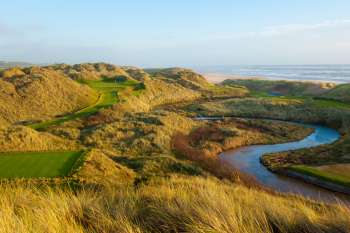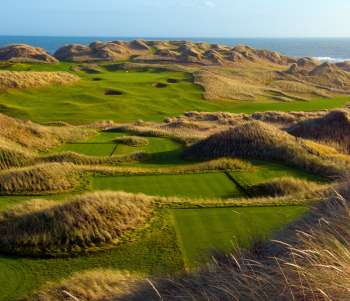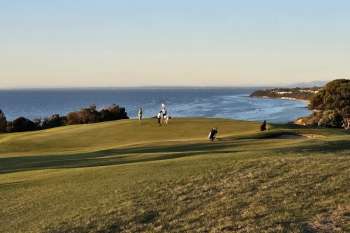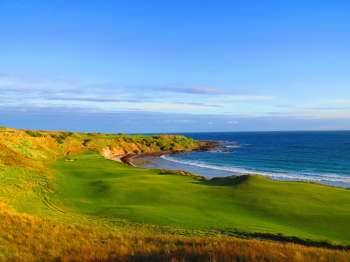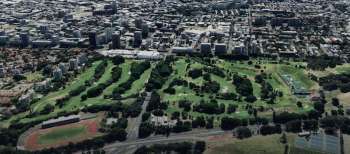Trump Card - Is this the World's Greatest Golf Course?
American entrepreneur Donald Trump once famously said that, ‘sometimes your best investments are the ones you don't make.’ On the eve of the grand opening of his Trump International Golf Links in Scotland, those words are likely ringing true right now for the high-profile, multi-millionaire businessman.
Back in 2005 Mr. Trump was introduced to a tract of large sand dunes on the Menie Estate north of Aberdeen. It was love at first sight for this golf-keen New Yorker, who purchased the property and ambitiously declared that he was going to build the ‘world’s greatest golf course’ on it. The problem for Trump was that his heaviest dunes had been previously designated a Site of Special Scientific Interest (SSSI), and development of any sort was unlikely to win planning approval.
As is his way, Trump persisted and after the local council rejected his initial planning application in 2007 he went directly to the Scottish Government to seek a reversal. That reversal came after a protracted and bitter Public Inquiry, where Trump and his design team argued for the need to enter the protected SSSI area in order to create a world-class golf course. Despite strong objections from environmental groups, wildlife preservation bodies and Scottish Heritage, the government ultimately ruled that the benefits of attracting jobs and tourism to the area outweighed the likely damage done to the environment.
Trump’s triumph was significant on many levels. First the SSSI classification is the strictest in Europe, and development approval on such a site is extremely rare. These dunes are mobile, and were so sensitive to erosion and damage that in places people were not even allowed to walk through them, let alone build golf holes amongst them. Secondly, the overall masterplan for Trump International Scotland includes a hotel and leisure resort as well as more than 1,000 home sites. Governmental support for such a contentious, and highly commercial, development angered many people in Scotland.
Adding further fuel to the fire, for those upset about the manner in which this development was approved, came the recent news that Trump was now threatening to sue the very government that allowed him to build his golf course in the first place. According to Mr. Trump, he only proceeded with the building of his ‘world’s greatest’ links after assurances from senior ministers in the Scottish government that a mooted offshore wind farm in Aberdeen would not proceed. That energy project is now very much on the agenda, and its giant turbines will be located two kilometres from Trump’s golf course. According to the tycoon these turbines will damage the visual aesthetic of his coastal holes, and as a result he is postponing the rest of his £750m development and preparing to sue the Scottish parliament. Whether Trump believes he has a serious legal case here or is merely bluffing to pressure the government into yet another reversal only time will tell. Either way, it’s unlikely that the £50m spent thus far building the golf course feels like one of his better investments.
Without the associated hotel, resort and residential components, Mr. Trump will be hoping that his golf links will be able to attract significant business to not only cover further expenses but perhaps claw back some of his considerable outgoings. Ignoring the hyperbole surrounding the development, this Martin Hawtree-designed links is clearly not the best in the world but it does have considerable appeal. Most golfers, for instance, will enjoy playing surfaces that, superficially at least, are superior to most of the old links in Scotland. The bent-fescue greens and green surrounds are superb, and the striped fescue fairways already provide golfers with a pristine carpet from which to play.
The dunes are also very impressive. Renamed the ‘Great Dunes of Scotland’ by Trump himself, some of the sand structures tower more than 80 feet above the playing areas. As Hawtree’s routing is very linear in nature, the majority of his holes play either north or south and directly through natural valleys created by the various dunes and ridges. There is a genuine sense of isolation and tranquillity across the course, and while the routing lacks the directional shifts and variety of the truly great links, there are nonetheless a number of beautiful golf areas here.
The best of these are the par threes, which as a set are as attractive as any in the country. The 3rdhas seven tee boxes, and from the high right side is played directly toward the sea. The green here is protected by a single bunker on the right, and an unseen inlet of the North Sea on the left. It is particularly impressive when viewed from the 4th tee looking back. The next short hole on the front side, the 6th (below), is perhaps the visual highlight of the entire course, as it features a green site perched above a curving burn and benched into some of the heaviest dunes on the outward side. Some golfers will find the hole a little intimidating, but hitting the putting surface with your tee shot here is an undeniable thrill.
Of the remaining par threes the angled 16th, which is protected by a string of bunkers cut into its front and left side, is perhaps the only moderately interesting short hole at Trump. The 13th, by contrast, is spectacular and notable for two reasons. Firstly it’s the only hole to break from the otherwise north-south orientation of the routing. Secondly, the shot demanded here is played across a shallow valley to a gorgeous green framed by the sea and a series of tepee shaped dunes. The use of native marram grasses to add definition here is very striking. The fact that it’s the only hole on the course that plays directly toward or away from the sea, however, is a little disappointing.
Also disappointing is the design of some of Hawtree’s longer holes. The par fives are particularly curious, and are either over-bunkered in the case of the 4th and the 18th, or simply ill-conceived in the case of the split-fairway 10th. The 10th is an essentially straight three-shotter that has an alternate fairway which must add at least 60-70 metres to the length of the hole, and is also harder to hit from the tee. The green here is tucked awkwardly into an immense dune amphitheatre and is certainly better approached from the right hand side, but is only reachable in two by elite, power golfers. Whether anyone chooses to turn a straight hole into a sharp dogleg and play down the right remains to be seen.
Of the remaining holes, the par fours, a handful have strong strategic merit and will be exciting to play. The softly bending 11th and 12th are both really nice, as are the relatively subtle mid-length 5th and 15th holes. The undoubted two-shot star, though, is the seaside 14th, which heads along a narrow valley between two towering dune ridges. The view from up on any of the high tees here is quite breathtaking. The problem, as with other parts of the course, is that the fairway itself is fairly tight, and given winds will typically buffet golfers from the side the prospect of lost balls, and slow rounds, is very high.
Problems with the 14th are reflective of serious design issues across the entire Trump International Golf Links layout. The course is simply too difficult for the average golfer, and there are numerous examples of narrow fairways are cut through penal marram grasses. There are also more than 100 tee boxes on the course which one suspects will cause operational headaches as amateur visitors attempt to marry the need to play from appropriate tees with a desire to see this beast in all its visual glory. Hawtree has admitted that he is uncomfortable about some of the elevated tees, and with good reason too as players with poorer techniques are likely to find the narrow fairways even harder to hit from such elevation. The other concern with having so many tees is that the course invariably becomes longer to walk, and therefore longer to play. Even fast fourballs playing solid golf will struggle to keep rounds under four and a half hours. Busy days with high winds could be brutal here.
Despite these concerns, not all golfers will find being stuck on the Trump course in Aberdeen for five hours a chore. The dunes are superb, the views are often beautiful and those who enjoy being pampered will find the grooming a step up from most other links in Scotland. The shame really is that the design team have been unable to find a harmonious balance between wanting to wow golfers and test the best professionals, with the need to keep the game fun and playable for the vast majority. Given the lessons learned by failed development over the past few decades, it was a surprise to see something so overtly nasty and difficult built on such a windswept site.
In terms of the Hawtree routing, sticking all of his golf into the heaviest dunes was obviously a key to ensuring that each hole was dramatic and memorable. Whether it allowed him to build the best course possible, however, is debatable. Mr. Trump indicated that his architect had 600 acres at his disposal for this project, and there is no doubt that pushing some of the holes onto the flatter peripheral areas would have yielded a more playable and more balanced golf course. Given the client and his early proclamations about this being the world’s best golf course, it might have been difficult for the designer to sacrifice scenery for the sake of routing balance. Whether the decision was the right one ultimately depends on patronage, and the preparedness of visitors to continually pay to play a course that will likely beat most of them up quite badly.
There is no doubt that given the principals involved, and the enormity of these dunes, the Trump International Golf Links was always destined to become one of the most polarizing courses in Scotland. While most golfers and golf writers are likely to gush over the place, it is difficult to see seasoned travellers being completely satisfied with the offerings. It is also difficult to see, even with the most ambitious financial forecasts, the project being able to turn a decent profit, given the seasonality of the locale and the stiff competition from neighbouring clubs. It remains to be seen, therefore, whether this will end up being one of Donald Trump’s best investments, or perhaps the ‘one that he shouldn’t have made’.
Either way, the Aberdeenshire coast is a fantastic place for golf and if Trump does eventually build his hotel and resort the hope is that the development will encourage an influx of tourism, and allow more golfers to discover the charms of local gems like Royal Aberdeen, Cruden Bay and Murcar.
Back to NewsMore News
Report reveals golf's $3.3 billion contribution to Australia
AGIC report reveals total annual benefits to the Australian community, economy and environment from golf.
Cape Wickham Links – The Inside Design Story
Co-designer Darius Oliver reveals the truth behind the design of Australia’s premier modern golf course
Min Woo Lee signs up for Aussie PGA title defence
Reigning champion locks in the defence of his title at Royal Queensland Golf Club in November
Have your say on the future of Moore Park Golf
Golfers unite – another one of our cherished public access golf courses is under threat
